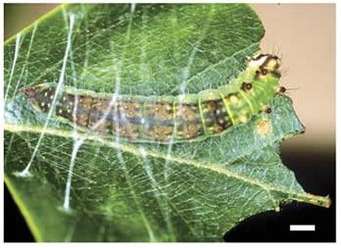March 1, 2017 report
Caterpillars found to use vibrations to attract other caterpillars

(Phys.org)—A small team of researchers with members from institutions in Canada and Brazil has found that one species of caterpillar uses parts of its body to create vibrational noises that attract others of its kind. In their paper published in the journal Behavioral Ecology and Sociobiology, the team describes their study of the tiny insects and the possible impact their results could have on pesticide development.
Prior research had shown that the tiny birch caterpillar uses parts of its body to communicate with other caterpillars. In this new effort, the researchers found that the caterpillars use more body parts than originally thought, and use them to communicate in a number of ways.
To learn more about communication among birch caterpillars, the researchers captured several specimens and brought them into their lab for study. They placed them on birch leaves and then set up microphones capable of capturing the sounds made by the insects, which are inaudible to humans, along with cameras to capture the action.
In studying the resulting videos the researchers found that the caterpillars made four main types of sounds, all believed to be associated with feeding and making silk—birch caterpillars make cocoons as a group, sharing the workload. The actual sounds, the team found, were made in several ways—by rubbing or scraping mouth parts (mainly mandibles) against a leaf, by shaking their bodies or by dragging anal parts against a leaf surface.
The research team has not yet figured out why the simple caterpillar needs to make such a variety of sounds, but suggest it has to do with drawing others of its kind closer and to help with working together. Some sounds may indicate that food has been found, for example, while others note problems. The team also found that on occasion, a solitary caterpillar would make a certain sound and within a couple of hours, several other caterpillars would make their way over to it.
It has been noted that cracking the communications used by caterpillars could lead to developing a new kind of pesticide—jammers that prevent them from sharing feeding tips, engaging in cocoon building or perhaps from resolving differences among themselves.
More information: C. Yadav et al. Invitation by vibration: recruitment to feeding shelters in social caterpillars, Behavioral Ecology and Sociobiology (2017). DOI: 10.1007/s00265-017-2280-x
Abstract
Sociality is widespread in caterpillars, but the communication mechanisms used for group formation and cohesion are poorly understood. Here, we present the first evidence that caterpillars produce complex vibratory signals to advertise food and shelter sites to conspecifics. We first tested the hypothesis that early instars of the masked birch caterpillar (Drepana arcuata) actively form groups. Larvae placed alone on different leaves of a birch twig began assembling within minutes and forming groups of 2–6 at a median time of 2 h. In Y-choice experiments, larvae joined arms occupied by conspecifics significantly more frequently than unoccupied arms. To test the hypothesis that group formation is vibration-mediated, signals were monitored in solitary residents of silk leaf shelters before and during natural recruitment events. Four distinct signal types were recorded: anal scraping, mandible drumming, mandible scraping, and buzz scraping. Anal scraping and buzz scraping were the most common in residents prior to being approached, and these signals were strongly correlated to feeding and laying silk. Signaling occurred in 100% of residents, and higher signal rates resulted in significantly faster recruitment times. As a recruit approached a resident, complex signaling interactions occurred, which may communicate information about resource quality or location. We conclude that caterpillars, similar to other social animals, use acoustic communication to advertise resources. The vibratory signaling repertoire of these tiny caterpillars exhibits a complexity rivaling that of eusocial insects. Further investigations of vibroacoustic communication are essential to fully appreciate the intricacies of social interactions in caterpillars and other juvenile insects.
Journal information: Nature Communications , Behavioral Ecology and Sociobiology
© 2017 Phys.org




















